2021 Mazda MX-30 E35 Astina review
The importance of the Mazda MX-30 cannot be overstated. No car manufacturer represented in Australia with a battery electric vehicle in its line-up has greater sales or more market recognition than the Japanese brand.
Only Toyota does better and its first BEV – the bZ4X – is still not due until mid-2022.
So when Mazda rolls out its first zero emissions electric vehicle it’s bound to garner lots of attention. Sadly, in this case, not for all the right reasons.
READ MORE: Mazda all in on EVs – 13 new models by 2025
Value: Mazda MX-30
Available to to order now and to collect from late August, the $64,950 (plus on-road costs) 2021 Mazda MX-30 Astina E35 (to give it its full name) is not exorbitantly expensive as far as battery electric vehicles go.
The problem, as we explore below, is the dollars spent for the short 200km range on offer just don’t stack up.

At around $70K on the road before state government subsidies (if you live in the right places), the MX-30 is a compact SUV that lines up directly against the Hyundai Kona Electric and Kia Niro on price. But it’s also butting up against the entry-level Tesla Model 3, Australia’s most popular EV. For reference, the MX-30 is almost identical in size to the Mazda CX-30 that slots between the CX-3 adn CX-5 and gets regular doors.
That’s a hard sell. In fact Mazda says it expects only about 100 buyers this year. There are more cars available from the factory in Japan if demand is higher.
Still, Mazda has tried to stake its claim by endowing the MX-30 with lots of equipment and character. The latter first; its rear-hinged rear doors are a rarity in the automotive world and are a great talking point. There’s also some cool interior design bits and bobs, which we’ll get into.
MX-30 equipment highlights include 18-inch alloy wheels, a glass sunroof, seat and steering wheel heating, 10-way power adjustment and two-position memory for the driver’s seat, an 8.8-inch non-touch infotainment screen, Apple CarPlay and Android Auto connection, sat-nav and 12-speaker Bose audio. There are two USB ports but no wireless charging.
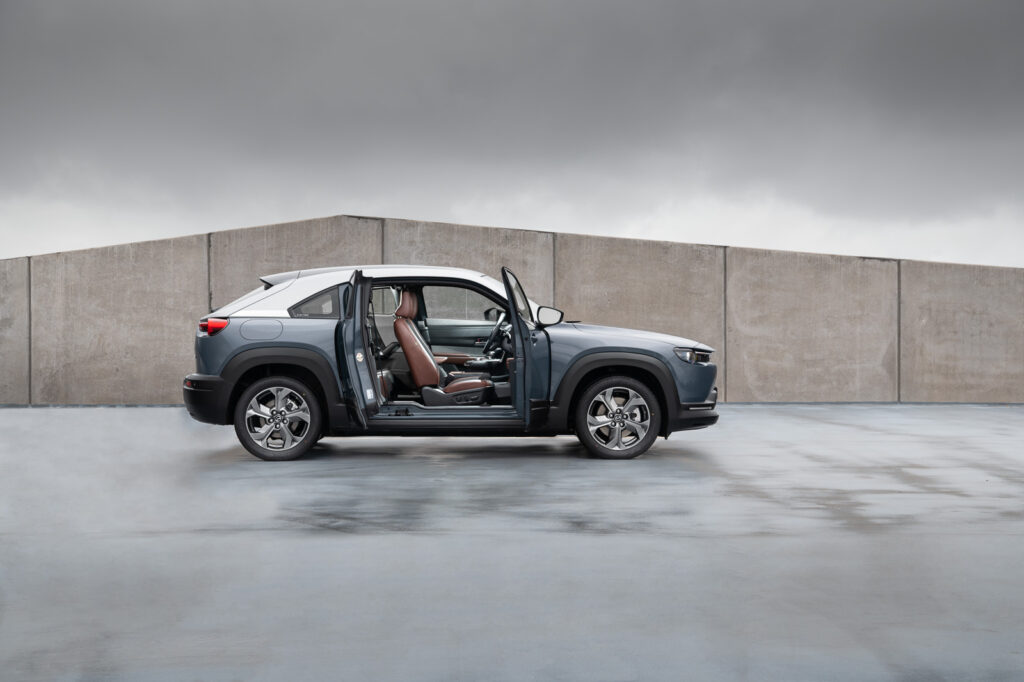
You only get single zone climate control, but in an EV it’s best to avoid the AC and use far more frugal seat heating if you’re cold. If you’re hot? Wind down a window. The seat trim is an artificial leather called Maztex rather the real cow, but that’s probably a positive not a problem for potential MX-30 buyers (although the steering wheel is made of real leather, so it partially cancels that out…). They’ll also like it’s made using water rather than solvents.
There is no power tailgate and no spare tyre in the boot, which even in an urban vehicle like this is pretty disappointing. At least you do get tyre pressure monitoring.
The MX-30 comes with a five-year/unlimited kilometre warranty and five-year roadside assistance. A five-year service plan is just $1273.79, which is far cheaper than what’s usually charged for ICE vehicles.
By the way, the MX-30 line-up also includes an extremely mild hybrid priced from $33,990 and will add a range-extender with a rotary engine in 2022. That vehicle is expected in Australia, ahead of a new generation of BEVs and PHEVs coming by 2025.
Inside the Mazda MX-30
Those rear-hinged doors really do grab a lot of attention, but they are not that functional. You have to open and close the front doors before you can open and close them and getting in or out of the rear seat is pretty challenging because of the small opening. There is a power adjust button on the top of the front seat to aid exit.
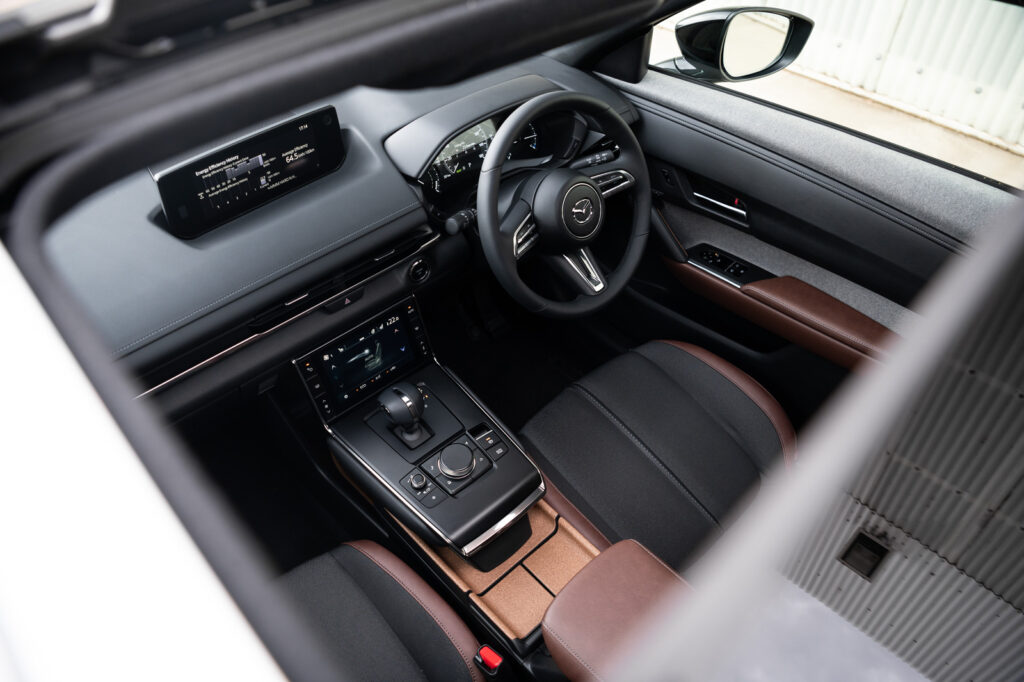
Once in the rear-seat you’ll find leg and head space pretty limited. The boot is also on the small side at 311 litres. No wonder Mazda says this is a car for couples rather than families.
Those couples will find themselves well looked after up-front. There are design innovations like the ‘floating’ centre console, which means it has a hollowed-out storage area underneath where USB inputs, a 240V powerpoint plug and the like are tucked away.
The driving position is a mix of orthodox and just that bit of difference; a round reach and rake manual-adjust steering wheel, a stubby gear lever and a three-dial instrument display with the speedo in the centre, a power meter on the left and battery health indicators on the right. The seat is firm with some bolstering, but it’s not too racy.
Typical of recent Mazdas, the operating buttons on the steering wheel for things like the AC are small and the text on them can be hard to read.
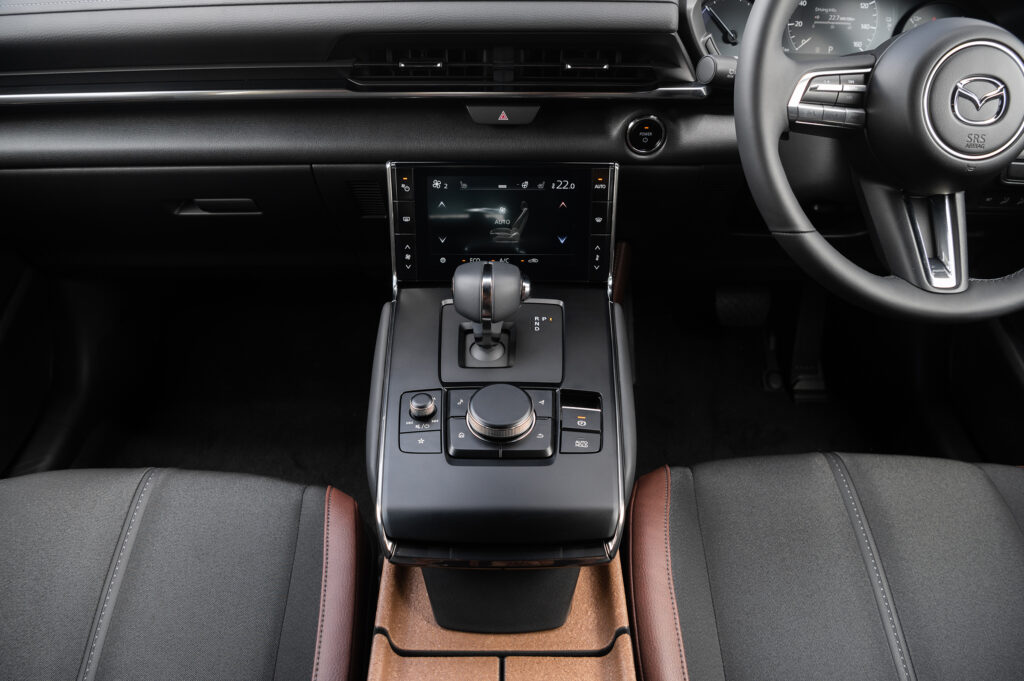
There’s a pleasing level of enviro-friendly recycling. For instance, cork from bottle stoppers is used in door grips and the centre console. This material also plays into Mazda’s heritage as it was established as a cork-maker in 1920.
Dunno what’s used for the dashboard top but it’s pretty hard to the touch. It doesn’t feel particularly premium.
Performance and efficiency
This is where the MX-30 struggles to make sense. Officially, according to Australian Design Rules testing (and to get the figure for the sticker on the windscreen), it claims a 224km range between recharges. But under the globally recognised WLTP testing protocol, it is just 200km.
That’s because the MX-30 is fitted with a small 35.5kWh lithium-ion battery pack and the usable capacity is more like 30kWh. That’s about half the capacity its rivals offer.
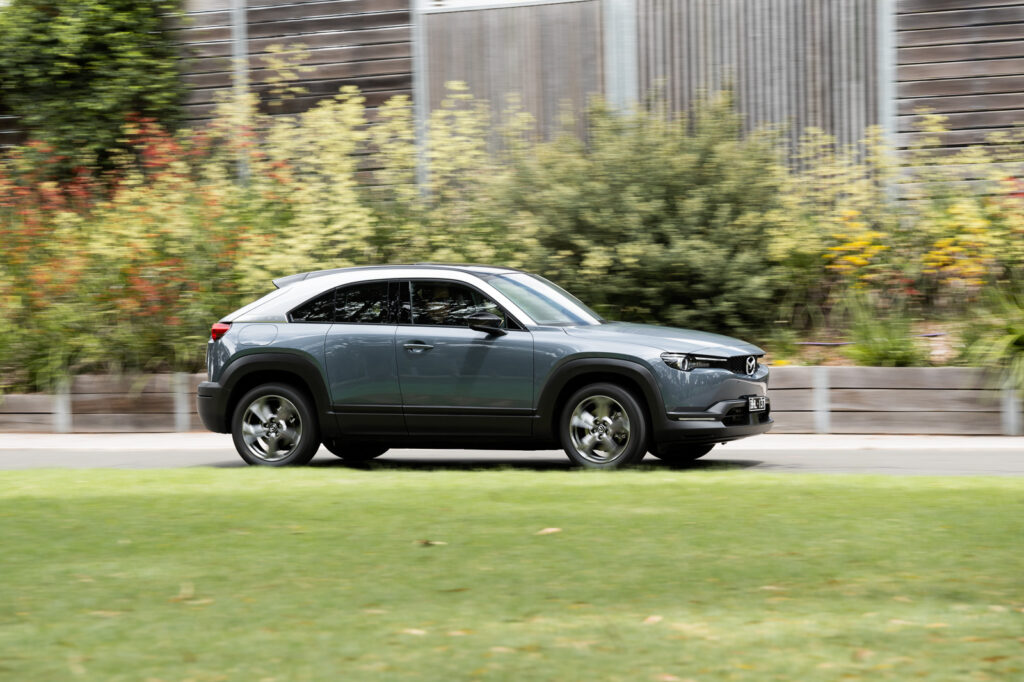
So no surprise the WLTP claims are so much more impressive for the Tesla Model 3 at 448km, the Kona at 484km and the Niro at 455km.
Mazda officially claims a consumption rate of 18.5kWh/100km. In our city and suburban drive loop at the launch, the trip computer was showing 17.4kWh/100km. Just for comparison sake, the Tesla Model 3 Standard Range Plus rates about 15kWh/100km, sometimes less.
The MX-30 has a 107kW/271Nm e-motor driving the front wheels via a single speed reduction gear. This delivers decent performance around town, especially for the cut and thrust of busy traffic.

The level of regenerative braking is set via flappy paddles on the steering wheel, with two levels of retardation or coasting either side of a neutral position. It was fun to use the left paddle to max braking into corners and then tap on the right paddle to cut resistance and get a boost on the exit.
One neat MX-30 touch is a faintly mechanical engine-like noise that pipes into the cabin reflecting the e-motor’s torque output. Even with that in the background, it’s always pretty quiet in the cabin.
Charging the Mazda MX-30
Plug your MX-30 into a standard 240V, 10A power point and it will charge from 20-80 percent in a round nine hours.
Upgrade to an AC wallbox or public charge at a maximum 6.6kWh and the MX-30 will recharge from 20-80 per cent in about three hours using a Type 2 plug.
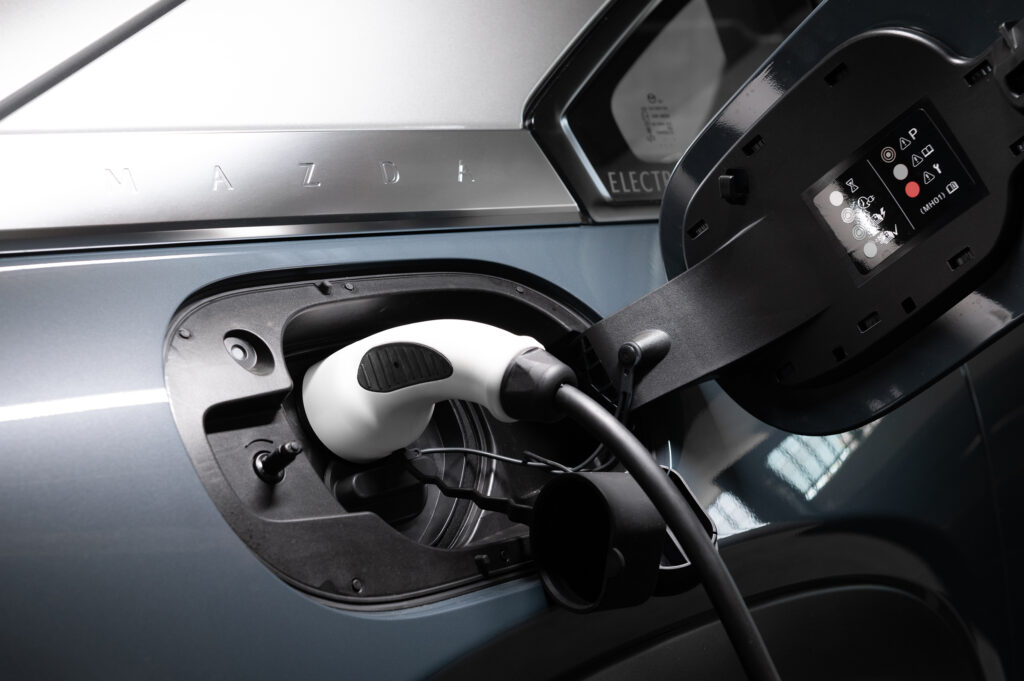
The MX-30 can DC fast-charge only at rate only up to 50kWh, but the small battery pack can reach 80 percent charge in just 36 minutes.
Like all EVs using a Type 2 CCS combo plug (almost all of the EVs available in Australia) the MX-30 is not capable of bi-directional charging.
Ride and handling
Another advantage of a small battery pack is relatively light weight – at least compared to other BEVs. The MX-30 weighs in at 1670kg, which isn’t hopelessly far from ICE levels. That helps both performance (see above), ride quality and handling.
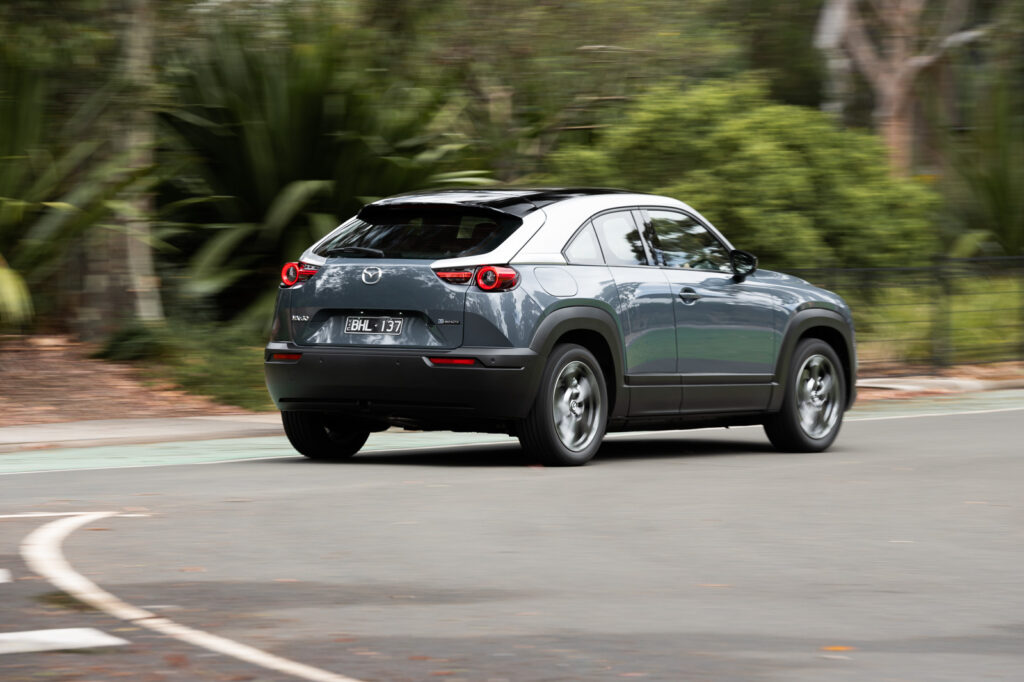
Fitting the pack under the floor means centre of gravity is lower and therefore handling is further assisted. Light and quick electric assist steering and simple but well-tuned MacPherson strut front- and torsion beam rear-suspension help ensure the MX-30 is an enjoyable and mostly comfortable drive.
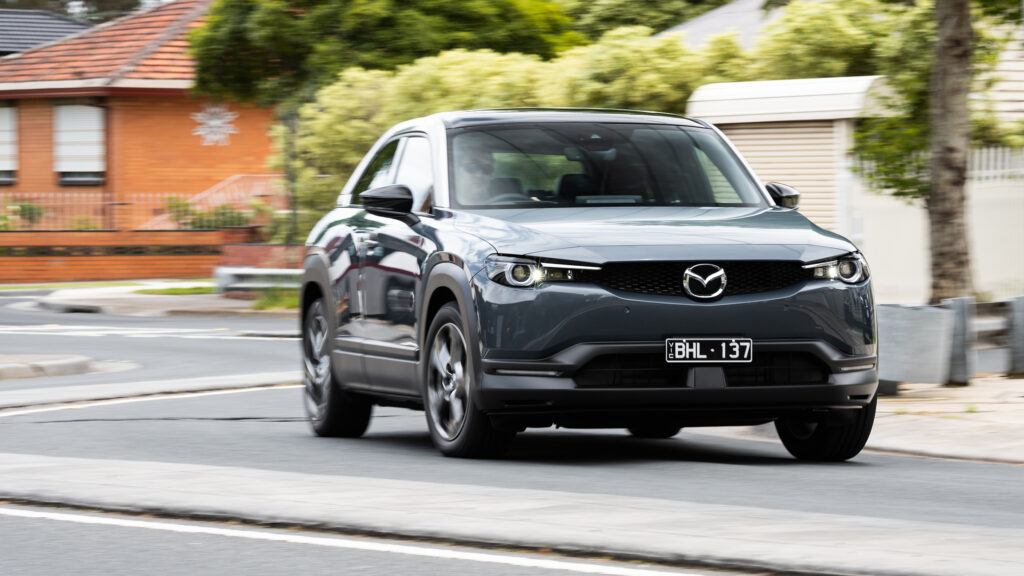
It has a slightly stiff-legged ride familiar from other Mazdas, especially at low speed. Every now and again there was a noticeable thump or intrusion into the cabin off a sharp edge.
Talking point
Mazda says it opted for such a small battery pack in the MX-30 for environmental reasons: “Its size was chosen to minimise CO2 emissions throughout its life cycle, from initial resource extraction to installation, full-cycle usage and finally battery disposal.”
So if batteries are such a big part of BEV costs, why is the MX-30 so expensive with such a small pack? Here’s what Mazda marketing director Alastair Doak told EV Central:
“We brought the car in at as high a spec as we possibly can, that’s usually where the demand is for early adopters for new models. You’d think that would be especially so for an EV as well.”
Safety
Mazda prides itself on achieving maximum five-star ANCAP safety ratings and the MX-30 doesn’t let it down.
Tested against the stringent 2020-22 protocols by ANCAP’s European partner EuroNCAP, the MX-30 did its best work in the adult occupant protection tests.
But it was found to need improvement when it came to pedestrian and cyclist detection by the autonomous emergency braking system.

AEB – which in this case brakes the car to avoid front, rear and crossing obstacles – is far from the only driver assist system the MX-30 features. Adaptive cruise control, blind spot monitoring, lane keep assist and front and rear cross traffic alert are also very helpful parts of a comprehensive package.
That stuff comes in use because the MX-30’s thick B-pillar created by the front and rear door posts, the C-pillar and the D-pillar mean right-side head-check visibility in traffics isn’t great.
A little more prosaic but also very handy are front and rear parking sensors, a reversing camera, traffic sign recognition and excellent LED headlights.
There is no head-up display or HUD, which projects key info onto the windscreen in front of the driver. Maybe not essential, but very handy.
Verdict
Park your logical brain at the rear-hinged doors and the MX-30 comes across as a fun, original and enjoyable small passenger car – officially it’s an SUV but it’s hard to see how that classification is justified.
But the moment a skerrick of the rational returns the MX-30 loses out because of its poor value proposition.
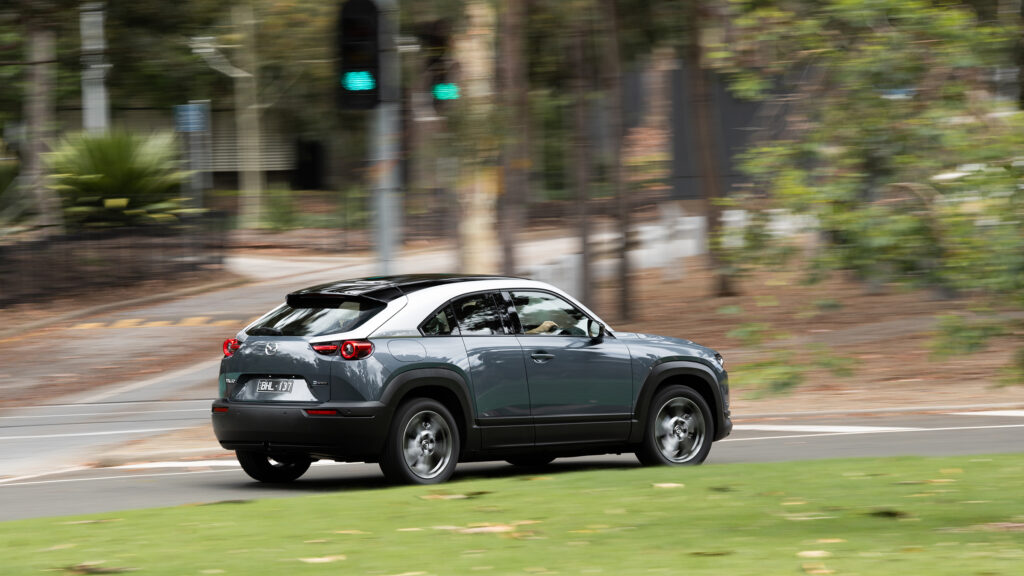
If you want to be among the very first Mazda BEV owners in Australia then go for it and grab an MX-30. Otherwise, wait and see what’s coming down the track; Mazda has announced 13 EV and hybrid models by 2025 and Mazda Australia wants every one of them. , it’s bound to be cheaper, have a longer range and – being a Mazda – a pretty decent vehicle to drive.
Mazda MX-30 E35 Astina specifications
Price: $64,950 (plus on-road costs)
Basics: EV, 5 seats, 5 doors, compact SUV, FWD
Range: 200km (WLTP)
Battery capacity: 35.5kWh (30kWh usable)
Battery warranty: 8 years, 160,000km
Energy consumption: 18.5kWh/100 km
Motor: 1 front, 107kW/271Nm
AC charging: 6.6kW, Type 2 plug
DC Charging: 50kW, Type 2 CCS combo plug
0-100km/h: NA

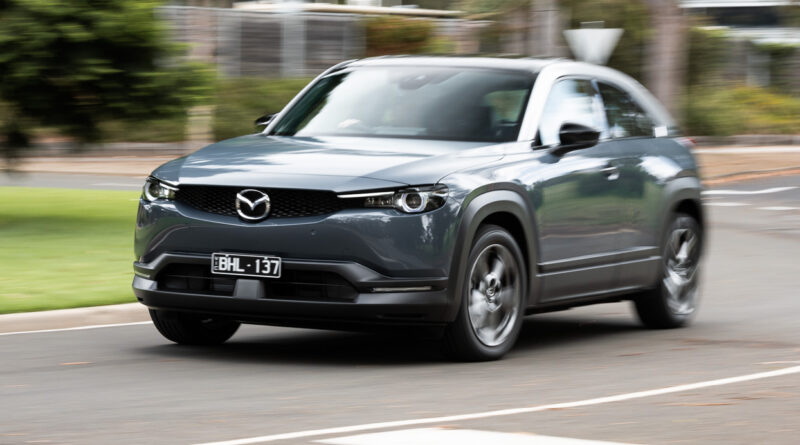

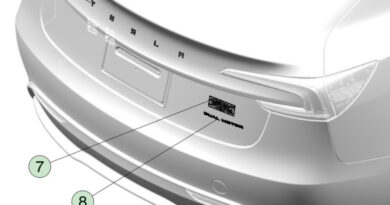
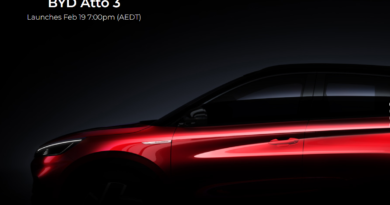
I am looking to purchase my first EV, so keenly read each of your reviews.
I’m interested to find out why you don’t include the Nissan Leaf e+ in your comparisons for range and price – 160kW motor, 56kWh battery, 385km range, $61k on the road.
Initially I discounted the Leaf from my considerations because of its limited range, but the Leaf e+ is on a par with the Kona Electric and Tesla 3.
Hi Alan, you’re abolsutely right about the Nissan Leaf e+ being in this group. We mentioned the Tesla because it’s a top-seller, the Kona because it’s an SUV (as the MX is supposedly meant to be) and the Niro as a recent arrival. There was no specific reason the Leaf e+ wasn’t mentioned. Check out our Leaf e+ review for more info on it. Good luck with the move to electrification!